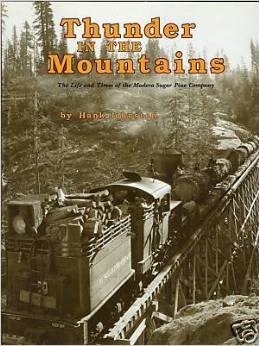Courtesy of Museums & Historic Sites of Southern Yosemite
Books are the life-blood of a region for the knowledge they impart. We want you to know about the wealth of books available to you from local sources that give you an insight into the region in which you live.
The holidays are coming soon, and we invite you to consider giving yourself, and everyone on your list, a wonderful book for enjoyment. You will be thanked many times over.
Give the gift of reading this Holiday season!
These books are available at the Coarsegold Historic Museum, 31899 Highway 41, Sierra Historic Sites Association on Road 427 in Oakhurst, Yosemite Mountain Sugar Pine Railroad, 56001 Highway 41 in Fish Camp, the Sierra Mono Museum, 33103 Road 228 in North Fork or online (as noted).
~~~~~~~~~~~~~~~~~~~~~~~~~~~~~~~~~~~~~~~
Miners, Lumberjacks and Cowboys; A History of Eastern Madera County, by Dwight H. Barnes; 2001 $15
 In a short 150 years, what now is called Eastern Madera County went from a quiet land populated only by Indians living close to nature to a bustling, rural community which retains an independent mountain spirit while offering diverse economic and social opportunities. As it was for all of California, the transition was dramatic, full of ups and downs. Halfway through [its] period, for instance, it was forecast that Oakhurst, now a thriving community of more [than] 13,000, was headed for oblivion as just another of the many ghost towns found along the Mother Lode.
In a short 150 years, what now is called Eastern Madera County went from a quiet land populated only by Indians living close to nature to a bustling, rural community which retains an independent mountain spirit while offering diverse economic and social opportunities. As it was for all of California, the transition was dramatic, full of ups and downs. Halfway through [its] period, for instance, it was forecast that Oakhurst, now a thriving community of more [than] 13,000, was headed for oblivion as just another of the many ghost towns found along the Mother Lode.
Miners, Lumberjacks and Cowboys is the story of the people who settled in the foothills and mountains of the Sierra Nevada to build their lives, raise their families, first looking for gold, then turning to the “green gold” of the forest, harvesting its timber, pasturing cattle and sheep and capitalizing on recreational values….
~~~~~~~~~~~~~~~~~~~~~~~~~~~~~~~~~~~~~~
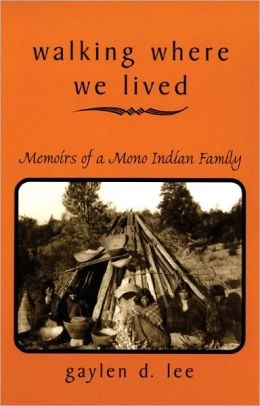 walking where we lived; Memoirs of a Mono Indian Family by gaylen d. lee. [Note: The use of lower and upper case letters follows the style used by the author on the book.] 1998 $18
walking where we lived; Memoirs of a Mono Indian Family by gaylen d. lee. [Note: The use of lower and upper case letters follows the style used by the author on the book.] 1998 $18
Galen D. Lee is a descendent of the Pomona family, traditional leaders of the Nim’s Eagle clan. A self-employed upholsterer, he has been active in the preservation of his family’s culture throughout his life.
The Nim (North Fork Mono) Indians have lived for centuries in a remote region of California’s Sierra Nevada. In this memoir, Gaylen D. Lee recounts the story of his Nim family across six generations. Drawing from the recollections of his grandparents, mother, and other relatives, Lee provides a deeply personal account of his people’s history and culture. In keeping with the Nim’s traditional lifestyle, Lee’s memoir takes us through their annual seasonal cycle. He describes communal activities, such as food gathering, hunting and fishing, the processing of acorn (the Nim’s staple food), basket-making, and ceremonies and games. Family photographs, some dating to the beginning of this century, enliven Lee’s descriptions.
Woven into the seasonal account is the disturbing story of Hispanic and white encroachment into the Nim world. Lee shows how the Mexican presence in the early nineteenth century, the Gold Rush, the Protestant conversion movement, and, more recently, the establishment of a national forest on traditional land have contributed to the erosion of Nim culture.
The Bakersfield Californian noted…”Non-American Indians reading Walking Where We Lived may have to rethink everything they once believed about California’s indigenous population….Lee’s book…is a celebration of his family and families like his who have managed to survive and perpetuate their culture, religion, and values despite the onslaught of intruders.”
~~~~~~~~~~~~~~~~~~~~~~~~~~~~~~~~~~~~~~
Willow Creek History; Tales of Cow Camps, Shake Makers & Basket Weavers by Marcia Penner Freedman. 2013 $20

It’s the same Willow Creek that flows into Bass Lake and moves through five powerhouses generating twenty-seven kilowatts of electricity for California. It’s the same Willow Creek that rises at eight thousand feet in the Sierra Forest, crashes through narrow granite canyons and meanders through serene mountain passes on its journey to its confluence with the San Joaquin River twenty-five miles below. Logging railroads have carried their loads alongside and over Willow Creek. Native tribes made their homes along its banks. Each year, thousands of people swim and boat and fish in its waters. In this history of Willow Creek, local author Marcia Penner Freedman shares the amazing story of these moving waters and the people whose lives have been touched by Willow Creek.
~~~~~~~~~~~~~~~~~~~~~~~~~~~~~~~~~~~~~~
An Interpretive Guide to the NELDER GROVE Area Including Trail Descriptions and Sequoia Facts: Brenda Negley. 2011. This booklet can be down-loaded – free!: http://www.neldergrove.org
About Nelder Grove: The grove consists of approximately 1,540 acres in the Sierra National Forest. Currently there are about 100 mature sequoias mixed in a forest of pine, fir and cedar.
Nelder Grove is found by traveling seven miles east on Road 632, Sky Ranch Road. Turn left on dirt road 6S47Y, and drive about one mile. Turn right for campground and other trails. Turn left at 5S19. The campground/trails are about one mile from the fork.
~~~~~~~~~~~~~~~~~~~~~~~~~~~~~~~~~~~~~~
Following the Bells; Traveling High Sierra Wilderness Trails by Johnny Jones, as told to Dwight H. Barnes 1994 $15
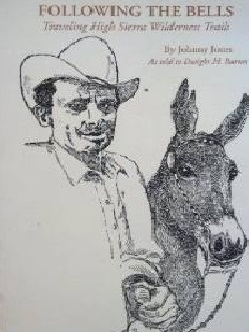 Mules and horses were a part of Johnny Jones’ life since early childhood. Long before he entered high school, he started following the long ears riding a mower and rake cutting alfalfa on the family farm.
Mules and horses were a part of Johnny Jones’ life since early childhood. Long before he entered high school, he started following the long ears riding a mower and rake cutting alfalfa on the family farm.
In the 60-plus years that followed, Jones, who sometimes was called “Jackass Johnny” in school, became widely known as one of the leading High Sierra guides and packers, a respected mule judge and breeder of world champion performance and racing mules. …this is his story about his beloved Sierra and the years when the bells of a mule train or grazing livestock were his favorite music.
~~~~~~~~~~~~~~~~~~~~~~~~~~~~~~~~~~~~~~
Mountain Memories; The Gold Years: Sierra Historic Sites Assn; 2003 $7
It was gold that first brought non-natives to the region now known as Eastern Madera County…this [book] is devoted to gold mining. [These are] sketches recalling the rich cultural heritage which our region enjoys. …these will prove of interest and will light a spark of curiosity about the manner in which our area grew.
~~~~~~~~~~~~~~~~~~~~~~~~~~~~~~~~~~~~~~
Lion Singer: Sylvia Ross 2005 $13 This is a delightful book for children ages 8 – 12. CG Museum
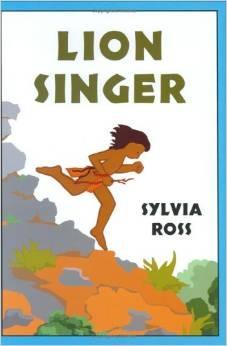 Before there were cars or television sets—before there was even steel and plastic to build them with—in a time when much of California was covered in swamps, meadows and forests, there lived a boy of the Chukchansi tribe in the foothills of the great Sierra.
Before there were cars or television sets—before there was even steel and plastic to build them with—in a time when much of California was covered in swamps, meadows and forests, there lived a boy of the Chukchansi tribe in the foothills of the great Sierra.
Dog Cry is a medium-sized name for a medium-sized boy. He is supposed to look after his little sister, but all he wants to do is run and adventure in the mountains with his cousins. The thrill of freedom quickly turns to fear, however, when he realizes that his sister has followed him and is in grave danger.
Finding courage and skills he didn’t know he had, Dog Cry comes to his sister’s aid. For his bravery, the tribal elders given him a new name: Lion Singer.
~~~~~~~~~~~~~~~~~~~~~~~~~~~~~~~~~~~~~
Secrets of the Oak Woodlands; Plants & Animals Among California’s Oaks: Kate Marianchild & Ann Meyer Maglinte 2014 $19
 California’s oak woodlands are home to more species of plants, fungi, birds, reptiles, amphibians, insects and mammals than any other terrestrial ecosystem in the state. This extensively researched, deeply felt and beautifully written guide reveals the wonders of these remarkable communities—and, with its vivid, detailed watercolors, it introduces you to a host of creatures in a world close by: a world that “rustles, hums and sings with the sounds of wild things.”
California’s oak woodlands are home to more species of plants, fungi, birds, reptiles, amphibians, insects and mammals than any other terrestrial ecosystem in the state. This extensively researched, deeply felt and beautifully written guide reveals the wonders of these remarkable communities—and, with its vivid, detailed watercolors, it introduces you to a host of creatures in a world close by: a world that “rustles, hums and sings with the sounds of wild things.”
This is a NEW nature-guidebook that will capture the reader’s interest—and everyone who picks it up from the coffee table! Wonderful gift! This can be found at the Coarsegold Historic Museum.
~~~~~~~~~~~~~~~~~~~~~~~~~~~~~~~~~~~~~~
The Little Church on the Hill; A Monument to Volunteerism, by Dwight H. Barnes who was the Historian at Sierra Historic Sites Assn. 2005 $10
The Little Church…book introduces the reader to a wonderful chapel now standing in the Oakhurst Cemetery. It had been built in 1892-94 and sat on top of Chapel Hill at Road 426 and 425B, the location of the original town of “Fresno Flats.” In 1957 the church was painstakingly moved from that site to the cemetery where it is today.
The reader will become acquainted with Father McGowan who came to the area to pastor and build Christ Church and learn the history of the building with its diamond pattern stained glass windows. These windows have been replicated through pictures and shards of glass found at the old site.
Over the years, the church has had its times of disrepair followed by urgent cries to bring it up to the fine building it is today. Read the history…this book is truly a keepsake!
~~~~~~~~~~~~~~~~~~~~~~~~~~~~~~~~~~~~~~
Exploring the Sierra Vista National Scenic Byway: Hidden Heart of the Central Sierra: Roger & Loris Mitchell 2006 $15
 There seems to be no firm and hardened definition of just what a “Scenic Byway” is. However, most highway professionals define a scenic byway as a roadway having at least one of the following intrinsic values: Scenic, Natural, Historic, Cultural, Archaeological and Recreational.
There seems to be no firm and hardened definition of just what a “Scenic Byway” is. However, most highway professionals define a scenic byway as a roadway having at least one of the following intrinsic values: Scenic, Natural, Historic, Cultural, Archaeological and Recreational.
By any measurement, the Sierra Vista National Scenic Byway meets not just one of these criteria, but five of them! As a guide to all the sights and history along the road, this booklet is a must. To travel the Byway without it is to miss the essence of a wonderful adventure!
~~~~~~~~~~~~~~~~~~~~~~~~~~~~~~~~~~~~~~
Sierra Vista National Scenic Byway Audio Tour: This is a CD available at the Mono Museum. It includes 15 “chapters” with an original sound track composed by John Kilburn. Explanations are clear and enhance the route (map included) found in the Exploring… book in the entry above. Information: www.sierravistascenicbyway.org
~~~~~~~~~~~~~~~~~~~~~~~~~~~~~~~~~~~~~~
High Odyssey: The true story of Orland Bartholomew’s 1928-29 Mt. Whitney to Yosemite expedition—one of America’s great mountaineering adventures: Gene Rose 1987 $15
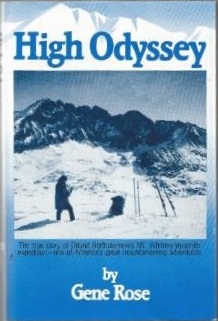 Imagine standing in the midst of a vast, snow-covered mountain range—all alone. Before you loom towering peaks, where avalanche-laden slopes hang menacingly. Suddenly, a storm descends. Sheets of snow and ice sting your face; a biting cold snaps at the tips of your skis, while gale-force winds whip your burdened body. Then the clouds drop and you find yourself engulfed in a ghostly whiteout.
Imagine standing in the midst of a vast, snow-covered mountain range—all alone. Before you loom towering peaks, where avalanche-laden slopes hang menacingly. Suddenly, a storm descends. Sheets of snow and ice sting your face; a biting cold snaps at the tips of your skis, while gale-force winds whip your burdened body. Then the clouds drop and you find yourself engulfed in a ghostly whiteout.
…there is one who pushes on, alone and unaided. He is Orland Bartholomew, who, long before marked trails, modern mountaineering equipment and helicopter rescues, fought his way up the towering crest of the Sierra during his one-man…expedition.
If you know the High Sierra, if you delight in adventure, Bartholomew’s epic journey will fascinate you. Mountaineers and adventurers describe his accomplishment as America’s most ambitious and thrilling feat of ski mountaineering.
~~~~~~~~~~~~~~~~~~~~~~~~~~~~~~~~~~~~~~
To Yosemite by Stage: Raymond to Wawona and Remembering Cedarbrook Inn: Zelda Garey Dubel 2011 (See ordering information below.)
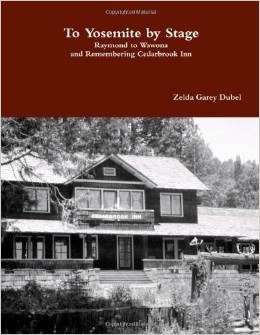 This is an historic account of the horse-drawn stage route for tourists between Raymond and Wawona from 1886 to about 1913. The trip was forty-two miles and took twelve hours, with a luncheon stop in Ahwahnee. The narrow, winding, dirt road was all uphill, requiring changes of horses about every eight miles.
This is an historic account of the horse-drawn stage route for tourists between Raymond and Wawona from 1886 to about 1913. The trip was forty-two miles and took twelve hours, with a luncheon stop in Ahwahnee. The narrow, winding, dirt road was all uphill, requiring changes of horses about every eight miles.
They passed gold mines, hotels, stores, post offices, an abundance of saloons and Cedarbrook Inn. Stage hold-ups remind one of the wild west. From research in three counties, the author has recounted details about the early settlements and genealogical information about the settlers. Indexed.
Order from www.Lulu.com The hard-bound copy is 462 pages, 8 ½ x 11. The paperback copy is $30.
~~~~~~~~~~~~~~~~~~~~~~~~~~~~~~~~~~~~~~
As We Were Told, Vol. I; An Oral and Written History 1990 $49 (incl. tax) The most important project the Coarsegold Historical Society undertook in the 1990s was to record on tape the history of the southern end of the Sierra foothill area as related by long-time residents and those having access to significant historical information. The recordings were then put on paper and the resulting book holds the histories of 102 families and individuals who lived and molded life in Eastern Madera County.
~~~~~~~~~~~~~~~~~~~~~~~~~~~~~~~~~~~~~~
As We Were Told, Vol II; An Oral and Written History 2009 $38 (incl. tax) This Volume II is similar to Volume I, with interviews of the “old timers,” but also includes several stories about the area, such as John Shay’s turn-of-the-century book, Twenty Years in the Backwoods of California.
~~~~~~~~~~~~~~~~~~~~~~~~~~~~~~~~~~~~~~
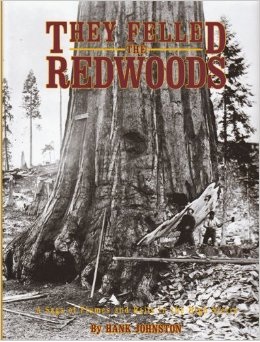 Four books on the history of the Sugar Pine area are Thunder in the Mountains, They Felled the Redwoods, The Whistles Blow No More and Rails to the Minarets. These four books are hardbound with lots of photos. They are available at the Yosemite Mountain Sugar Pine Railroad for $39.95 each. Author is Hank Johnston.
Four books on the history of the Sugar Pine area are Thunder in the Mountains, They Felled the Redwoods, The Whistles Blow No More and Rails to the Minarets. These four books are hardbound with lots of photos. They are available at the Yosemite Mountain Sugar Pine Railroad for $39.95 each. Author is Hank Johnston.
~~~~~~~~~~~~~~~~~~~~~~~~~~~~~~~~~~~~~~
Open up a new world through reading about what happened “here” before you arrived!
Children respond to adventures…introduce them to something new through books.
The Coarsegold Historic Museum’s phone is 559-642-4448. They close their doors at the end of October, but they do have staff there every Monday who are available to get phone messages and make arrangements for books.
www.southyosemitemuseums.org Newsletter Editor: Kay Good, chs@sti.net

